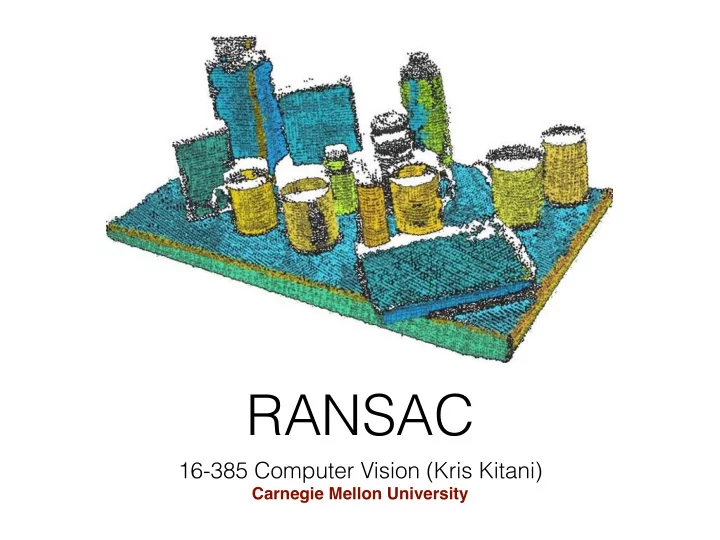

RANSAC 16-385 Computer Vision (Kris Kitani) Carnegie Mellon University
Up to now, we’ve assumed correct correspondences
What if there are mismatches? outlier How would you find just the inliers?
RANSAC RAN dom SA mple C onsensus [Fischler & Bolles in ’81]
Fitting lines (with outliers) Algorithm: 1. Sample (randomly) the number of points required to fit the model 2. Solve for model parameters using samples 3. Score by the fraction of inliers within a preset threshold of the model Repeat 1-3 until the best model is found with high confidence
Fitting lines (with outliers) Algorithm: 1. Sample (randomly) the number of points required to fit the model 2. Solve for model parameters using samples 3. Score by the fraction of inliers within a preset threshold of the model Repeat 1-3 until the best model is found with high confidence
Fitting lines (with outliers) Algorithm: 1. Sample (randomly) the number of points required to fit the model 2. Solve for model parameters using samples 3. Score by the fraction of inliers within a preset threshold of the model Repeat 1-3 until the best model is found with high confidence
Fitting lines (with outliers) δ N 6 = I Algorithm: 1. Sample (randomly) the number of points required to fit the model 2. Solve for model parameters using samples 3. Score by the fraction of inliers within a preset threshold of the model Repeat 1-3 until the best model is found with high confidence
Fitting lines (with outliers) δ N 14 = I Algorithm: 1. Sample (randomly) the number of points required to fit the model 2. Solve for model parameters using samples 3. Score by the fraction of inliers within a preset threshold of the model Repeat 1-3 until the best model is found with high confidence
How to choose parameters? • Number of samples N – Choose N so that, with probability p, at least one random sample is free from outliers (e.g. p=0.99) (outlier ratio: e ) • Number of sampled points s – Minimum number needed to fit the model • Distance threshold δ – Choose δ so that a good point with noise is likely (e.g., prob=0.95) within threshold – Zero-mean Gaussian noise with std. dev. σ : t 2 =3.84 σ 2 proportion of outliers e log(1 − p ) s 5% 10% 20% 25% 30% 40% 50% N = 2 2 3 5 6 7 11 17 ✓ ◆ 3 3 4 7 9 11 19 35 log 1 − (1 − e ) s 4 3 5 9 13 17 34 72 5 4 6 12 17 26 57 146 6 4 7 16 24 37 97 293 7 4 8 20 33 54 163 588 8 5 9 26 44 78 272 1177
Good • Robust to outliers • Applicable for larger number of parameters than Hough transform • Parameters are easier to choose than Hough transform Bad • Computational time grows quickly with fraction of outliers and number of parameters • Not good for getting multiple fits Common applications • Computing a homography (e.g., image stitching) • Estimating fundamental matrix (relating two views)
Given two images… find matching features (e.g., SIFT)
Matched points will usually contain bad correspondences bad correspondence good correspondence how should we estimate the transform?
LLS or DLT will find the ‘average’ transform ‘average’ transform solution is corrupted by bad correspondences
Use RANSAC How many correspondences to compute translation transform?
Need only one correspondence , to find translation model
Pick one correspondence , count inliers one correspondence
Pick one correspondence, count inliers 2 inliers
Pick one correspondence , count inliers one correspondence
Pick one correspondence, count inliers 5 inliers
Pick one correspondence, count inliers 5 inliers Pick the model with the highest number of inliers!
Estimating homography using RANSAC • RANSAC loop 1. Get four point correspondences (randomly) 2. Compute H (DLT) 3. Count inliers 4. Keep if largest number of inliers • Recompute H using all inliers
Estimating homography using RANSAC • RANSAC loop 1. Get four point correspondences (randomly) 2. Compute H using DLT 3. Count inliers 4. Keep if largest number of inliers • Recompute H using all inliers
Estimating homography using RANSAC • RANSAC loop 1. Get four point correspondences (randomly) 2. Compute H using DLT 3. Count inliers 4. Keep if largest number of inliers • Recompute H using all inliers
Estimating homography using RANSAC • RANSAC loop 1. Get four point correspondences (randomly) 2. Compute H using DLT 3. Count inliers 4. Keep H if largest number of inliers • Recompute H using all inliers
Estimating homography using RANSAC • RANSAC loop 1. Get four point correspondences (randomly) 2. Compute H using DLT 3. Count inliers 4. Keep H if largest number of inliers • Recompute H using all inliers
Useful for…
Recommend
More recommend